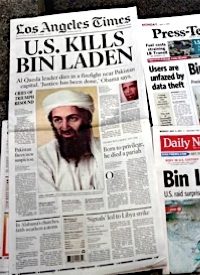
Days after telling the American people that a team of U.S. Navy SEALs had killed Osama bin Laden in a daring raid on a fortress where he was holed up in Pakistan, President Obama made the decision not to release images of the dead terrorist leader, claiming the photos would be too graphic and might lead to retaliation by Islamic militants. “In deciding not to make public the pictures of the corpse,” reported Reuters, “Obama resisted arguments that to do so could counter skeptics who have argued there is no proof that bin Laden, who was rapidly buried at sea by U.S. forces, is dead.”
White House spokesman Jay Carney said that images taken after the assault showed “someone who was shot in the head. It is not in our national security interest to allow those images … to become icons to rally opinion against the United States. The President’s number one priority is the safety and security of American citizens at home and Americans abroad. There is no need to release these photographs to establish Osama bin Laden’s identity.”
Carney emphasized that there was “no question at all that Osama bin Laden is dead. He will not walk this earth again. We have established beyond any doubt through DNA evidence, facial recognition, visual recognition … that Osama bin Laden was shot and killed on Sunday night.”
President Obama himself explained to a CBS News 60 Minutes interviewer that “given the graphic nature of these photos, it would create some national security risk,” adding, “It is important for us to make sure that very graphic photos of somebody who was shot in the head are not floating around as an incitement to additional violence — as a propaganda tool.” As if reading from the same script as Carney, President emphasized that there was “no doubt that Bin Laden is dead, and so we don’t think that a photograph in and of itself is going to make any difference. There are going be some folks who deny it. The fact of the matter is, you will not see bin Laden walking on this earth again.”
{modulepos inner_text_ad}
Patricia Reilly, whose sister was killed in the attack on the World Trade Center on September 11, 2001, told ABC News, “I agree with his reason for not sharing them if it would incite people. People who are bent on attacking us again are still going to do it. But there is no reason to give people on the fence a reason to do something terrible.”
But Bill Doyle, whose father was killed in the same attack, said, “I know why people don’t want the photos released. But I know a woman whose husband was identified because they found his heart. How much more gruesome can the photos of bin Laden be?”
While the White House said that U.S. Secretary of Defense Robert Gates and Secretary of State Hillary Clinton had concurred with the President’s decision, CIA Director Leon Panetta apparently missed the presidential memo, saying, “I think we have to reveal to the rest of the world the fact that we were able to get him and kill him.”
Similarly, former New York City Mayor Rudolph Giuliani, who was hailed as a hero for his handling of the aftermath of the terrorist attack on his city, predicted that the images of bin Laden “are eventually going to get out. Why not put them out now, satisfy at least the rational people.”
Not wishing to walk into dangerous political waters, high-profile Republicans were inclined to give the President the benefit of the doubt, with GOP presidential front-runner Mitt Romney telling Politico.com, “It’s best not to release the photo because it has the potential to incite retaliatory violence against Americans.” Similarly, Senator John McCain (R-Ariz.) said that his initial take was that “it’s not necessary” to show the images. “I think there’s ample proof that this was Osama bin Laden, but I will defer to the judgment of the President of the United States.”
And Representative Mike Rodgers (R-Mich.), chairman of the House Intelligence Committee, offered his own meandering affirmation of the President’s decision, telling reporters, “Here’s the problem — if you’re a sergeant in a town in … Afghanistan and you’re trying to get some local elder to cooperate on what’s happening in your village, are you going to do it if this inflames into some kind of trophy of Osama bin Laden.”
Predictably, among the President’s opponents who criticized him for the decision was Sarah Palin, who tweeted what her approach would have been: “Show photo as warning to others seeking America’s destruction. No pussy-footing around, no politicking, no drama; it’s part of the mission.”
Others suggested that the President needed to come clean with the photographic evidence to put to rest any murmurings of so-called “conspiracy theorists.”
“There’s no doubt that they got him,” announced Representative Peter King (R-N.Y.), whose constituency included families of those killed in the World Trade Center attacks. “Let’s not have any conspiracy theories develop. From what I’ve heard of the photos, they’re not ghoulish … they’re not going to scare anybody off.”
But it didn’t take “right-wing conspiracy nuts” to suggest that the absence of photos and, among other strange circumstances, the quick and “private” burial of bin Laden’s body at sea might signify that something was amiss in the Hollywood-quality storyline of the SEALS’ derring-do.
“Sorry, But I Don’t Believe This,” novelist, filmmaker, and inveterate blogger Gonzalo Lira titled his posting the day after the President’s glorious announcement of the death of bin Laden. Pointing out that his regular readers know he is no conspiracy nut — “I believe Elvis is dead, I believe Paul never died, I believe 9/11 was a terrorist incident, and I believe Neil Armstrong did in fact land on the moon” — Lira nonetheless declared that “I don’t believe Osama Bin Laden was killed over the weekend.”
While saying he didn’t buy the larger-than-life plot trotted out by the military and White House, Lira clarified that “I do not believe Bin Laden is still alive.” Instead, he explained, “I believe what a lot of intelligence analysts have been privately saying for a long time now: That Bin Laden died of kidney failure in December 2001, and that he was buried by his followers in an unmarked grave in the mountains between Afghanistan and Pakistan.”
Lira pointed out that around the time of the 9/11 attacks bin Laden was commonly believed to be afflicted with a severe kidney ailment that, minus regular dialysis or a kidney transplant — “neither which would have been available to him in the aftermath of 9/11 — he wouldn’t have much chance of long term survival.”
Furthermore, he wrote, “From 2002 onward, there hasn’t been a single undisputed Bin Laden sighting — even though he was supposed to be the most hunted man on earth.” Add to this the fact that “in Bin Laden’s videotaped rants that were periodically released, he never referred to current events.” Most tellingly, wrote Lira, “the American military’s efforts to capture Bin Laden ‘dead or alive’ … dropped to almost nothing after 2003” — which would make no sense unless “you already know that the man is dead, and that his body will likely never be found.”
But now, in a whirlwind of activity, this most wanted terrorist is suddenly located, dispatched, and buried at sea — all with nothing but the “official word of the American defense and intelligence establishments,” which, Lira reminded his readers, have “always been so trustworthy.”
Reflecting the silent thoughts of more than a few other observers, Lira declared that the “whole story smells: where he was supposedly located; how he was shot twice in the head, rather than captured; how he was buried at sea; how there’s (so far) no picture of his corpse.”
If what Lira speculated is true, what would be the point of such an elaborate — and self-perpetuating — hoax? Lira threw out one theory that might tempt some Americans to applaud the President and his team of political conjurers for their audacity. “Perhaps — what with all this talk of "victory" — it might be that this was staged in order to give an excuse for rapid withdrawal not only from Afghanistan, but from Iraq as well,” suggested Lira.
With the nation “going literally bankrupt” in part on the government’s non-stop military spending, maybe what was needed was a representative death to justify a hasty retreat. In bin Laden, fact or fiction, Obama and company found their perfect scapegoat. “Perhaps,” speculated Lira, “this charade is an excuse to declare ‘victory’ and thereby end the endless Global War On Terror.”
Whatever the truth, which will most likely never be know with certainty, it is certain that the White House will continue to deal its cards sparingly, changing its story as needed, in order to draw out the façade of “victory” that bin Laden’s most recent death has created.
Photo: AP Images
Related articles:
Afghanistan: Will War, U.S. Occupation Continue in Perpetuity?
Bin Laden & al-Qaeda: U.S. Govt. Creations
Pakistan: Treacherous “Ally” Exposed — Again



